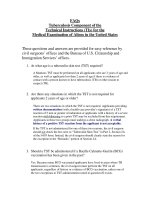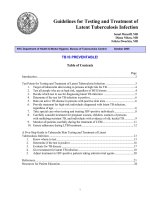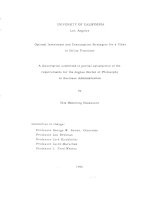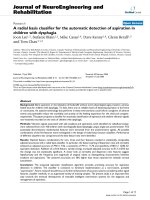ANTIBIOTIC GUIDELINES FOR THE EMPIRICAL TREATMENT OF SEPSIS IN IMMUNOCOMPETENT ADULTS
Bạn đang xem bản rút gọn của tài liệu. Xem và tải ngay bản đầy đủ của tài liệu tại đây (89.58 KB, 15 trang )
ANTIBIOTIC GUIDELINES FOR THE EMPIRICAL TREATMENT OF SEPSIS
IN IMMUNOCOMPETENT ADULTS
Version
•
3.0
Date ratified
•
March 2009
Review date
•
March 2011
Ratified by
•
Nottingham University Hospitals Antimicrobial Guidelines and
Drugs and Therapeutics Committee
Authors
•
Dr Farah Yazdani (SPR Microbiology) and Dr V Weston
Consultation
•
Nottingham Antimicrobial Guidelines Committee members
Evidence base
Local microbiological sensitivity surveillance and local audit of
ESBL positive E. coli bacteraemias
• Surviving sepsis campaign
• Recommended best practice based on clinical experience of
guideline developers
Changes from
previous Guideline
•
Algorithm for treatment of sepsis based on risk of multi-resistant
Gram negative infection
Inclusion criteria
•
Immuno-competent adult patients with sepsis
Exclusion criteria
•
Haematology and oncology patients, patients with neutropenic sepsis
(see separate guidance)
Distribution
•
This guideline will be available on the Clinical Effectiveness
Department Intranet page and the antibiotics guidelines websites:
http://nuhnet/diagnostics_clinical_support/antibiotics
Local contacts
•
Dr V Weston Consultant Microbiologist
•
This guideline has been registered with the Trust.
Clinical guidelines are guidelines only. The interpretation and application of clinical
guidelines will remain the responsibility of the individual clinician. If in doubt contact a senior
colleague. Caution is advised when using guidelines after a review date.
Nottingham Antimicrobial Guidelines Committee
March 2009 Review March 2011
-1 –
ANTIBIOTIC GUIDELINES FOR THE EMPIRICAL TREATMENT
OF SEPSIS IN IMMUNOCOMPETENT ADULTS
Contents:
Page 3-4
General guidance/ Current trends in Antibiotic Resistance
Page 5-10
Guidance on initial Antibiotic therapy by body site:
Abdominal Infection
Biliary Infection
Bone and Joint Infection
Cellulitis
Infective Endocarditis
Line infection (peripheral and central)
Urosepsis
NB Meningitis and Pneumonia (see separate guidelines)
Page 11
Algorithm for the Empirical treatment of suspected sepsis of unknown origin
Page 12-15
Vancomycin and Gentamicin dosing / monitoring and
calculation of GFR.
These guidelines detail the empirical antibiotic treatment of sepsis in
immunocompetent adults. Please see separate guidelines for the treatment
of neutropenic sepsis at:
http://nuhnet/diagnostics_clinical_support/antibiotics
Neutropenic patients should be discussed with a senior member of the
oncology or haematology team on-call.
Nottingham Antimicrobial Guidelines Committee
March 2009 Review March 2011
-2 –
General Guidance
In cases of sepsis in immunocompetent adults in whom the diagnosis is
unknown, empirical therapy based upon the likeliest of sources of bacteraemia is
necessary. If the source of sepsis is unknown please refer to the algorithm on
page 7.
Appropriate microbiological specimens should always be taken before starting
antibiotics. This should include two sets (four bottles) of blood cultures, each set
taken from separate sites (20ml/set). Blood cultures should also be taken from
all intravascular devices present, including central lines and Hickman lines and
labelled stating which line they were taken from.
Appropriate antibiotic therapy should be administered, within one hour for
inpatients and within three hours of the time of presentation for patients being
admitted.
Recent microbiology results should be reviewed to identify if the patient is at risk
of sepsis with a more resistant organism, which may not respond to standard first
line therapy.
Antibiotics are only part of the management of a patient with an infection.
Further details about the management and investigation of sepsis can be found
at the Surviving sepsis campaign website />
Current trends in Antibiotic Resistance
MRSA and Serious Infection
At present in Nottingham about 20% of Staphylococcus aureus bacteraemias
and septicaemias in adult patients are due to meticillin resistant S. aureus i.e.
MRSA; which will not be sensitive to the agents frequently used for S. aureus
sepsis, e.g. flucloxacillin and cefuroxime.
MRSA infection is more likely in current inpatients, but patients admitted from the
community are at risk of MRSA infection if they have any of the risk factors listed
below:
•
•
•
•
Recent treatment as an inpatient in the last 6 months or as an outpatient
with an indwelling line
Previous MRSA infection or colonisation
Long-term urinary catheter
Resident of a nursing or residential home with breaks in their skin e.g. leg
ulcers
Initial antibiotic treatment of sepsis of unknown aetiology or severe
staphylococcal infections should therefore be altered to cover the possibility of
MRSA in a patient who has any of these risk factors for MRSA infection. Further
therapy should be adjusted in light of the microbiological culture and sensitivity
results.
Nottingham Antimicrobial Guidelines Committee
March 2009 Review March 2011
-3 –
Multiresistant Gram Negative Bacilli (MRGNB)
Recent local, national and international surveillance has identified a worrying
increase in multiple resistance to antibiotics in Gram-negative bacilli; particularly
gentamicin, quinolone and cephalosporin resistant E. coli; with up to 10%
resistant to gentamicin and 3rd generation cephalosporins (ESBL positive), and
19% resistant to ciprofloxacin. This is of concern as E. coli is the most common
cause of community and hospital acquired Gram-negative sepsis.
Local surveillance has identified the following risk factors for ESBL positive E.
coli or multi- resistant Gram negative sepsis:
• Previous history of isolation of ESBL positive E coli or Multiresistant Gram
negative organisms
OR
• Recurrent urinary or biliary tract infections (>3 in last year)
• Sepsis despite current or recent (within the last week) treatment with broadspectrum antibiotics e.g. co-amoxiclav , cefuroxime or quinolones
(ciprofloxacin, levofloxacin)
To enable effective management of these patients, it is therefore important that
appropriate specimens (including blood cultures) are taken and their previous
microbiology reviewed.
Nottingham Antimicrobial Guidelines Committee
March 2009 Review March 2011
-4 –
Guidance on Initial Antibiotic Therapy by Body Site
All doses that are recommended in this guide are for those with normal renal
function – please check doses if renal impairment on antibiotic website
http://nuhnet/diagnostics_clinical_support/antibiotics
ABDOMINAL/BILIARY INFECTION
(See note regarding multi-resistant Gram negative bacilli (MRGNB) on page 4)
E.g. perforation of abdominal / gynaecological viscus – which is usually
polymicrobial:
Co-amoxiclav IV 1.2 g tds
Or
If rash with penicillins Cefuroxime IV 1.5g tds (Not to be used in serious
penicillin allergy, e.g. urticarial rash within the first 72 hours, anaphylaxis
or angioedema)+ Metronidazole IV 500mg tds
If the patient has severe sepsis or the blood pressure fails to
respond to initial fluid bolus:
+ Gentamicin IV 5 mg/kg (if normal renal function) as a single dose (max
500mg)
[See dosing advice in renal impairment page 13-15]
Further therapy
Review need for IV antibiotics at 48 hours with microbiology results see
IV-PO switch guideline on antibiotics website.
Total duration of IV+PO therapy 7 days
OR if risk of MRGNB (see page 4)
Meropenem IV 1g tds (review antibiotics with microbiology within 48
hours)
(Not to be used in serious penicillin allergy, e.g. anaphylaxis, contact
Microbiology for further advice)
If the patient has severe sepsis or the blood pressure fails to
respond to initial fluid bolus:
+ Gentamicin IV 5 mg/kg (if normal renal function) as a single dose (max
500mg)
[See dosing advice in renal impairment page 13-15]
BONE AND JOINT INFECTION
Joint aspiration and or deep bone specimens for Gram stain and culture (prior to
treatment if possible) are mandatory to establish the diagnosis and further
management. If unable to obtain a specimen contact the on-call rheumatologist
or orthopaedic surgeon.
Flucloxacillin IV 2g qds
(covers both Meticillin sensitive S. aureus and streptococcal infections)
Nottingham Antimicrobial Guidelines Committee
March 2009 Review March 2011
-5 –
Penicillin-allergy:
Clindamycin IV 600mg qds (change to oral when medically stable)
or
Cefuroxime IV 1.5g tds
(Not to be used in serious penicillin allergy, e.g. urticarial rash within the
first 72 hours, anaphylaxis or angioedema)
If MRSA infection is a possibility (see page 3)
Vancomycin IV 1g bd
(If mild renal impairment or age >65 years, reduce frequency to 1g od,
monitor levels - see page 12)
+ Cefuroxime IV 1.5 g tds (Not to be used in serious penicillin allergy, e.g.
anaphylaxis)
If suspected/proven Gram negative infection (elderly patients and/or
immunocompromised):
Cefuroxime IV 1.5g tds
(Not to be used in serious penicillin allergy, e.g. anaphylaxis)
If risk of MRGNB (see page 4) discuss treatment with the on call medical
microbiologist
If suspected/proven gonococcal infection:
Ceftriaxone IV 1g od
(Not to be used in serious penicillin allergy, e.g. anaphylaxis)
Further therapy
Further therapy should be discussed with a medical microbiologist as antibiotic
choice will need to be modified following the results of the Gram stain and
culture. Staphylococcal bone and joint infections are commonly treated with more
than one agent. If infection is confirmed the treatment is usually given for a total
of 4-6 weeks of which 2 weeks is given IV.
CELLULITIS
Therapy is usually directed at Streptococcus pyogenes (group A β-haemolytic
streptococcus) and S. aureus
When there are no signs of systemic upset, sepsis, or rapidly progressing
cellulitis:
Flucloxacillin PO 500mg-1g qds or if penicillin allergy Clarithromycin PO
500mg bd (not if known/likely MRSA infection)
When more severe or failed adequate doses of oral flucloxacillin:
Community acquired
Flucloxacillin IV 2g qds (covers both S. aureus and S. pyogenes).
Changing to oral flucloxacillin when cellulitis receding and systemically
stable
Review need for IV antibiotics at 48 hours with microbiology results see
IV-PO switch guideline on antibiotics website, usual total length of
treatment 5-7 days.
Nottingham Antimicrobial Guidelines Committee
March 2009 Review March 2011
-6 –
Penicillin allergy:
Clindamycin PO 450-600mg qds or IV 600mg qds if vomiting/ severe
sepsis (change to oral when medically stable)
Hospital acquired or where MRSA is a possibility (see page 2)
Vancomycin IV 1g bd
(If mild renal impairment or age >65 years, reduce frequency to 1g od,
monitor levels - see page 12)
If rapidly progressive cellulitis with shock, please discuss with a medical
microbiologist as the possibility of deeper infection, particularly necrotising
fasciitis should be considered, which is a medical and surgical emergency and
modification of the antibiotic therapy maybe required.
Unresponsive infection may be due to another diagnosis eg varicose eczema,
where a dermatology opinion may be appropriate.
INFECTIVE ENDOCARDITIS
It is essential to collect three sets of blood cultures, from separate sites
(20ml per set) before treatment.
NOTE: All therapy and investigation of cases of endocarditis or possible
endocarditis should be discussed with Microbiology/Infectious Diseases.
Therapy is determined by positive microbiology results. If the patient fulfils
the Dukes criteria for diagnosis but cultures are negative therapy is
directed to the likely causative organisms as advised by microbiology.
Please see separate guidance available on the antibiotic website:
http://nuhnet/diagnostics_clinical_support/antibiotics
LINE INFECTION
• PERIPHERAL CANNULA (VENFLON ) SITE
Usually due to S. aureus sepsis, 20% of which are resistant to
flucloxacillin i.e. MRSA.
Remove the cannula
If pus at site of an old venflon site, or mild erythema, but no signs of
sepsis, take blood cultures and swab any pus:
Doxycycline PO 100 mg bd for one day then 100mg od for 6 days, which
is active against most MRSA and MSSA.
Monitor line site closely to check response to treatment.
Any signs of severe infection, or spreading cellulitis:
Vancomycin IV 1g bd
(If mild renal impairment or age >65 years, reduce frequency to 1g od,
monitor levels - see page 12)
Nottingham Antimicrobial Guidelines Committee
March 2009 Review March 2011
-7 –
Change to IV Flucloxacillin 1-2 g qds if MSSA is isolated.
Review need for IV antibiotics at 48 hours with microbiology results see
IV-PO switch guideline on antibiotics website.
If meets criteria for oral switch and negative blood cultures PO
Flucloxacillin 500mg-1g qds.
Total duration of IV+PO therapy 7 days, 14 days if positive blood cultures
•
CENTRAL LINES (for haemodialysis, TPN and haematology lines see
separate specialty guidance)
Exit site infection (without sepsis)
If pain around exit site, purulent discharge or erythema / Induration around
exit site, take blood cultures through the line and peripherally and swab
any pus.
For temporary central lines
Remove line
Vancomycin IV 1g bd (If mild renal impairment or age >65 years, reduce
frequency to 1g od, monitor levels - see page 12). Review need for
vancomycin at 48 hours with clinical response and blood culture results.
Line-associated bacteraemia due to S. aureus should be treated with a
minimum of 14 days antibiotic therapy after line removal.
Change to Flucloxacillin IV1-2g qds if MSSA is isolated and not allergic.
Central-line associated bacteraemia due to Coagulase negative
staphylococci may respond to antibiotics without line removal, but relapse
is common.
Tunnelled line exit site infection
Assess tunnelled track for erythema, tenderness or induration and if
present see guideline below on tunnel-track infections.
Doxycycline 100mg PO BD (1st day) then OD for 14 days
or Flucloxacillin 500mg-1g qds if known MSSA and not allergic for 14
days
Tunnelled line track infections (Hickman lines and other tunnelled lines)
Remove line if possible
Vancomycin IV 1g bd (If mild renal impairment or age >65 years, reduce
frequency to 1g od, monitor levels - see page 12).
Nottingham Antimicrobial Guidelines Committee
March 2009 Review March 2011
-8 –
Change to Flucloxacillin IV 1-2g qds if meticillin sensitive S. aureus is
isolated and not allergic.
Review antibiotics with culture results
If difficult infection, discuss with microbiology regarding the addition of a
second agent.
Line-associated bacteraemia due to S. aureus should be treated by a
minimum of 14 days antibiotic therapy after line removal
For Central Line-associated Sepsis
Remove line if possible
Vancomycin IV 1g bd (If mild renal impairment or age >65 years, reduce
frequency to 1g od, monitor levels - see page 12).
If the patient has severe sepsis or the blood pressure fails to
respond to initial fluid bolus:
+ Gentamicin IV 5 mg/kg (if normal renal function) as a single dose (max
500mg)
[See dosing advice in renal impairment page 13-15]
Review antibiotic choice with culture results
Change to flucloxacillin IV 1-2g qds if MSSA is isolated.
MENINGITIS See separate guidelines.
PNEUMONIA See separate guidelines.
UROSEPSIS
(See note regarding multi-resistant gram negative bacilli on page 4)
Pyelonephritis is usually due to Gram negative bacilli:
Co-amoxiclav IV 1.2 g tds
Or
If rash with penicillins
Cefuroxime IV 1.5g tds (Not to be used in serious penicillin allergy, e.g.
urticarial rash within the first 72 hours, anaphylaxis or angioedema)
If the patient has severe sepsis or the blood pressure fails to
respond to initial fluid bolus:
+ Gentamicin IV 5 mg/kg (if normal renal function) as a single dose (max
500mg)
[See dosing advice in renal impairment page 13-15]
Nottingham Antimicrobial Guidelines Committee
March 2009 Review March 2011
-9 –
Further therapy
Review need for IV antibiotics at 48 hours with microbiology results see
IV-PO switch guideline on antibiotics website.
Total duration of IV+PO therapy 7-10 days
OR
OR if risk of MRGNB (see page 4)
Meropenem IV 1g tds (review antibiotics with microbiology within 48
hours)
(Not to be used in serious penicillin allergy, e.g. urticarial rash within the
first 72 hours, anaphylaxis or angioedema, please discuss with a medical
microbiologist)
If the patient has severe sepsis or the blood pressure fails to
respond to initial fluid bolus:
+ Gentamicin IV 5 mg/kg (if normal renal function) as a single dose (max
500mg)
[See dosing advice in renal impairment page 13-15]
OR
if patient has a severe allergy to penicillins (e.g. urticarial rash within the
first 72 hours, anaphylaxis or angioedema):
Ciprofloxacin PO 500mg bd, or if vomiting IV 400mg bd, after discussion
with duty medical microbiologist
If the patient has severe sepsis or the blood pressure fails to
respond to initial fluid bolus:
+ Gentamicin IV 5 mg/kg (if normal renal function) as a single dose (max
500mg)
[See dosing advice in renal impairment page 13-15]
Nottingham Antimicrobial Guidelines Committee
March 2009 Review March 2011
-10 –
Guidelines for Empirical Treatment of Suspected Sepsis of Unknown Origin
• Previous isolation of ESBL positive E coli or MRGNB
OR
• Recurrent urinary or biliary tract infections (>3 last year)
• Sepsis despite current or recent (within the last week)
treatment with broad-spectrum antibiotics e.g. coamoxiclav , cefuroxime or quinolones e.g. ciprofloxacin
YES
NO
Meropenem 1g tds (review antibiotics with
microbiology within 48 hours)
Plus if severe sepsis or the blood pressure
fails to respond to initial fluid bolus:
Gentamicin IV 5 mg/kg (if normal renal
function) as a single dose (max 500mg)
[See dosing advice in renal impairment page
13-15]
Cefuroxime 1.5g tds
Plus if severe sepsis or the blood pressure
fails to respond to initial fluid bolus:
Gentamicin IV 5 mg/kg (if normal renal
function) as a single dose (max 500mg)
[See dosing advice in renal impairment page
13-15]
When taking blood cultures, two sets of blood cultures should be
sent. Each set (two bottles) should be taken from separate
venepuncture sites.
In hours, the samples should be sent straight to microbiology.
Out of hours, samples should be taken to the incubator on A floor at
QMC or the incubator at pathology reception at City. They must not
be sent by tube system.
Nottingham Antimicrobial Guidelines Committee
March 2009 Review March 2011
-11 –
If in doubt discuss or if patient has a severe
allergy to penicillins (e.g. urticarial rash within the
first 72 hours, anaphylaxis or angioedema) with a
medical microbiologist/ on-call infectious
disease consultant
VANCOMYCIN DOSING AND MONITORING
Vancomycin is used parenterally for the treatment of resistant Gram-positive
infections. Serum monitoring of pre-dose levels is essential to ensure therapeutic
levels are achieved without renal toxicity.
The normal dose is 1g bd infused over 2 hours.
If mild renal impairment or age >65 years, frequency reduced to 1g od.
For moderate or severe renal impairment please see separate guidance
CrCl (ml/min)
Vancomycin Dose
20 – 50
(or >65 yrs if Crcl
>50ml/min)
1g od. Check pre dose level before third dose.
10 – 20
1g every 48 hours. Check pre dose level before second dose.
<10
1g stat (or 15mg/kg up to max 2g). Check level after 4-5 days. ONLY
re-dose when level <12mg/L. If deep seated infection when <15mg/L.
Ensure patients have a fluid balance chart and urine output is monitored
Monitoring of levels
• A pre-dose sample (red topped sample sent to microbiology) should be taken
before the third or fourth dose. Recommended pre-dose levels for deep
seated infection – bone/joint/pneumonia/endocarditis are 10-15mg/L, with
other infections levels of 5-15mg/L are acceptable.
• Give time of last dose and time sample taken, details of dose and latest
creatinine on the sample request form (without which the result cannot be
interpreted)
• The dose can be given after the pre-dose level is taken if the serum
creatinine is stable with good urine output
• It is not necessary to do a post dose level
• Try and time the dose so it is convenient for levels
• Results will be available on the results reporting system on the day that
the sample is received.
Nottingham Antimicrobial Guidelines Committee
March 2009 Review March 2011
-12 –
ONCE DAILY GENTAMICIN DOSING AND MONITORING
Gentamicin is an effective antibiotic for treating many infections, especially those
arising from the gastrointestinal and urinary tract or hospital-acquired pneumonia.
Recent studies have shown that gentamicin can be given as a single dose rather
than in divided doses. This is easier for the ward staff, requires fewer levels to be
taken, and appears to be less nephrotoxic. (The effect on ototoxicity is still
unclear.)
This regimen is ideal for short courses e.g. 5 days. Longer courses will need
conventional dosing. N.B. it is not appropriate for some patient groups either
because of lack of published data, or risk of accumulation and toxicity.
Not to be used in:
• Children, (Neonates follow separate cross-town NNU guidelines)
• Pregnancy
• Situations where gentamicin is added for synergistic effect e.g.
Endocarditis, Listeriosis.
• Ascites
• Major burns (>20% surface area)
Dosage:
• Use 5mg/kg/dose (up to a maximum of 500mg)
• Round the dose up or down to the nearest 40mg increment e.g. 320mg or
360mg
• Dose obese patients using the Gentamicin dosing calculator on the
antibiotic website (http://nuhnet/diagnostics_clinical_support/antibiotics)
• Give as an infusion over 60 minutes (in 100ml NaCl 0.9% or Dex 5%).
• In patients with established renal impairment (ie CrCl <40ml/min) the
dose must be reduced see below
• Many elderly patients have a CrCl below 50ml/min, which, because of
reduced muscle mass, may not be indicated by a raised creatinine level. It
is therefore prudent to assume at least mild renal impairment when
prescribing for this patient group.
ONCE DAILY GENTAMICIN DOSING IN ESTABLISHED RENAL IMPAIRMENT
CrCl 10 –40ml/min
3mg/kg stat (max 300mg)
Check levels 18–24 hours
after first dose.
Redose only when levels < 1 mg/L
CrCl <10 (severe)
2 mg/kg stat (max 200mg)
Redose according to levels
Close monitoring of blood levels
recommended and dose adjustment as
necessary
Nottingham Antimicrobial Guidelines Committee
March 2009 Review March 2011
-13 –
Calculation of Creatinine Clearance
The Cockcroft-Gault equation (below) should be used to calculate creatinine
clearance and gives an estimate of kidney function for the purposes of drug
dosing in renal impairment . Cockcroft-Gault CrCl estimates should be used
for drug dosing rather than the automated MDRD eGFR produced by the
clinical chemistry laboratory available on NOTIS/HISS. There can be a
significant difference between the results of the two calculations.
The Cockcroft-Gault equation is used to calculate creatinine clearance as an
estimate of GFR (ml/min):
CrCl (ml/min)
=
F x (140-age) x weight (kg)
Serum creatinine (micromol/L)
Where F = 1.23 (male), F = 1.04 (female)
•
•
where F
= 1.23 (male)
= 1.04 (female)
If patient is anuric, morbidly obese or in acute renal failure (ARF), this
equation will NOT give a true reflection of creatinine clearance.
Anuric and oliguric (<500ml/day) patients can be assumed to have a CrCl <
10ml/min (severe renal impairment)
A Creatinine Clearance Calculator is available on the Nottingham Hospitals
antibiotic website: http://nuhnet/diagnostics_cinical_support/antibiotics
Monitoring of Gentamicin levels and renal function
• Take a trough level 18-24 hours (red-topped sample to microbiology)
after the first dose, the ideal trough is less than 1.0mg/L
• Give time of last dose and time taken, details of dose and latest creatinine
on the sample request form (without which the results cannot be
interpreted).
• For a result to be returned the same day, samples must be at path lab
reception before 3.30pm on weekdays and before 10am on
weekends.
• In a patient <65 years, if the serum creatinine is normal with good
urine output give the second dose without waiting for the result.
• In a patient >65 years old or with abnormal renal function, await the
result before giving a second dose and obtain advice from the medical
microbiologist if the pre dose is level is >1.0 mg/l
• When the first dose of gentamicin has been given in the evening/night, the
level should be taken by 3.00pm the following day if this falls within the 1824 hour window, and sent for analysis immediately. If this is not possible
the doctor must decide whether the second dose of gentamicin is given
Nottingham Antimicrobial Guidelines Committee
March 2009 Review March 2011
-14 –
•
•
•
•
•
before the level is known. As a general guide, for patients over 65 years or
with impaired renal function, the level and dose may be delayed until the
next morning.
It is not necessary to do a post dose level
Results will be available on results reporting system on the day that the
sample is received.
Renal function should be checked at least three times a week and levels
should be checked twice weekly during a treatment course.
If renal function deteriorates then renal function should be checked daily
and gentamicin levels closely monitored. A dose reduction may be
required.
All patients prescribed more than one dose of Gentamicin should have a
fluid balance chart completed and urine output should be closely
monitored.
Nottingham Antimicrobial Guidelines Committee
March 2009 Review March 2011
-15 –









